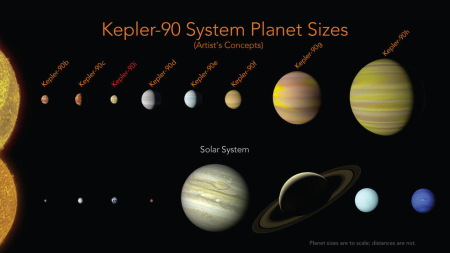New exoplanet makes eight in rival solar system

Worlds without end: Astronomers using Kepler data mined by computers have discovered an eighth planet in another solar system, making that system somewhat comparable to our own.
The newly discovered Kepler-90i — a sizzling hot, rocky planet orbiting its star once every 14.4 days — was found using computers that “learned” to find planets in data from NASA’s Kepler space telescope. Kepler finds distant planets beyond the solar system, or exoplanets, by detecting the minuscule change in brightness when a planet transits (crosses in front of) a star.
Vanderburg, a NASA Sagan fellow at UT Austin, and Shallue, a Google machine learning researcher, teamed up to train a computer to learn how to identify signs of an exoplanet in the light readings from distant stars recorded by Kepler. Similar to the way neurons connect in the human brain, this “neural network” sifted through the Kepler data to identify the weak transit signals from a previously missed eighth planet orbiting Kepler-90, a sun-like star 2,545 light-years from Earth in the constellation Draco. “For the first time since our solar system planets were discovered thousands of years ago, we know for sure that our solar system is not the sole record holder for the most planets,” Vanderburg said.
The image to the right compares the planet sizes between this solar system and ours. It does not show that, for this distant star, all eight planets have orbits closer to the star than the Earth, and would therefore be very unlikely to harbor life.
One more thing: This story is very cool, but it also is another one of those NASA press releases that the agency PR department overhyped beforehand, even allowing some reporters to think that it might involve the discovery of life beyond Earth. Not surprisingly, several news sources and radio shows asked me to talk about it. To their disappointment I said I’d rather wait, since NASA has overhyped more than a few stories like this in recent years. Once again, my instincts were right. This story has nothing to do with alien life, and though interesting, is actually not that big a deal.

Worlds without end: Astronomers using Kepler data mined by computers have discovered an eighth planet in another solar system, making that system somewhat comparable to our own.
The newly discovered Kepler-90i — a sizzling hot, rocky planet orbiting its star once every 14.4 days — was found using computers that “learned” to find planets in data from NASA’s Kepler space telescope. Kepler finds distant planets beyond the solar system, or exoplanets, by detecting the minuscule change in brightness when a planet transits (crosses in front of) a star.
Vanderburg, a NASA Sagan fellow at UT Austin, and Shallue, a Google machine learning researcher, teamed up to train a computer to learn how to identify signs of an exoplanet in the light readings from distant stars recorded by Kepler. Similar to the way neurons connect in the human brain, this “neural network” sifted through the Kepler data to identify the weak transit signals from a previously missed eighth planet orbiting Kepler-90, a sun-like star 2,545 light-years from Earth in the constellation Draco. “For the first time since our solar system planets were discovered thousands of years ago, we know for sure that our solar system is not the sole record holder for the most planets,” Vanderburg said.
The image to the right compares the planet sizes between this solar system and ours. It does not show that, for this distant star, all eight planets have orbits closer to the star than the Earth, and would therefore be very unlikely to harbor life.
One more thing: This story is very cool, but it also is another one of those NASA press releases that the agency PR department overhyped beforehand, even allowing some reporters to think that it might involve the discovery of life beyond Earth. Not surprisingly, several news sources and radio shows asked me to talk about it. To their disappointment I said I’d rather wait, since NASA has overhyped more than a few stories like this in recent years. Once again, my instincts were right. This story has nothing to do with alien life, and though interesting, is actually not that big a deal.






